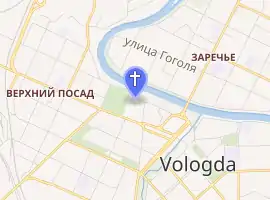Saint Sophia Cathedral, Vologda
Saint Sophia Cathedral (Russian: Софийский собор) is a Russian Orthodox cathedral, the oldest surviving stone building in the city of Vologda. It was constructed between 1568 and 1570 under personal supervision of Tsar Ivan the Terrible in the period when Vologda was the capital of the Oprichnina lands in Russia, and completed in 1587. The cathedral is located on the right bank of the Vologda River, just outside the former fortress known as the Vologda Kremlin.[1]
| Saint Sophia Cathedral | |
|---|---|
| Софийский собор | |
 The general view of the cathedral, 1977 | |

| |
| Location | Vologda |
| Country | Russia |
| Denomination | Russian Orthodox |
| History | |
| Founded | 1568 |
| Founder(s) | Ivan the Terrible |
| Dedication | Saint Sophia |
| Consecrated | 1587 |
| Architecture | |
| Style | Russian |
| Groundbreaking | 1568 |
| Completed | 1587 |
The cathedral was designated by the Russian government as an architectural monument of federal significance (#3510063013).[2]
History
The cathedral was built in 1568-1570, when Ivan the Terrible introduced the Oprichnina and made Vologda its capital. The model after which the cathedral was built was the Assumption Cathedral in the Moscow Kremlin. Ivan personally supervised the construction, and the builders were permitted to use almost unlimited resources. Ivan also, for unknown reason, ordered the cathedral's unusual orientation: its altar apse does not face east as is common in Orthodox Churches but rather northeast.[1] In 1571, Ivan the Terrible unexpectedly left Vologda and returned to Moscow. Soon afterwards, he abolished the Oprichnina and never showed any further interest in Vologda. He even gave an order for the cathedral to be demolished before he left the city, but subsequently withdrew it. By that time, the cathedral was constructed but not yet decorated or consecrated. The cathedral was completed during the reign of Feodor Ivanovich, the son of Ivan the Terrible, and consecrated in 1587.[1]
A legend says that the reason Ivan the Terrible left Vologda and ordered the demolition of unfinished cathedral was that during his visit on the construction site a brick from the bell tower fell on his head. [3]
The frescoes inside the cathedral were made between 1685 and 1687 by a group of painters from Yaroslavl under the direction of Dmitry Plekhanov.[1]
The bell-tower of the cathedral is the highest construction in Vologda, and is 78 metres (256 ft) high. The first wooden bell-tower of the cathedral was built at the end of the 16th century. The octagonal stone bell-tower was built in 1654-1659. The vaulted dome of the bell-tower in the pseudo-gothic style was built in 1869 by Vladimir Schildknecht, the chief architect of Vologda Governorate, by order of Bishop Palladius. The bells have proper names. The Big Holiday Bell was cast in 1687, the Water Carrier Bell was cast in 1643, the Watch Bell was cast in 1627, the Archangel Bell was cast in 1689, the Big Swan Bell was cast in 1689, and the Little Swan Bell was cast in 1656. The Bell-tower also known as a Watch tower. The chimes have been manufactured on the Brothers Gutenop factory in Moscow in 1871. The observation deck has a panoramic view.[4]
In Soviet times, the cathedral was shut down and now it serves as a museum.
References
| Wikimedia Commons has media related to Saint Sophia Cathedral (Vologda). |
- Вологодский Кремль - Софийский собор (in Russian). Культура в Вологодской области. Retrieved 23 December 2011.
- Собор Софийский (in Russian). Ministry of Culture of Russian Federation. Retrieved 22 December 2011.
- Иван Слободской. Летописец. 1716 год
- Минаев, Алексей Леонидович. "Вологодские губернские архитекторы конца XVIII – начала XX века" (in Russian). Известия Вологодского общества изучения Северного края. Retrieved 23 December 2011.